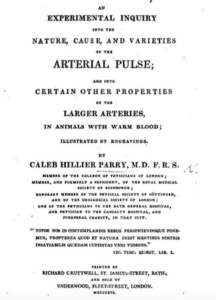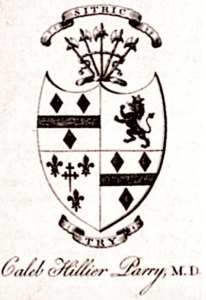JMS Pearce
Hull, England, United Kingdom
 |
| Fig 1. Caleb Hillier Parry |
Hyperthyroidism or exophthalmic goiter, often called Graves’ disease or Basedow’s disease, was first recorded by Caleb Parry (1755-1822) (Fig 1) posthumously in 1825. William Osler called the affliction “Parry’s disease.”
Caleb Parry was born in Cirencester, the son of Joshua Parry, a dissenting Presbyterian minister. He attended Cirencester Grammar School with Edward Jenner of vaccination fame, who became a lifelong friend. (Jenner dedicated his Inquiry into the causes and effects of the variolae vaccinae to Parry. And in 1814, Parry dedicated to Edward Jenner his Cases of Tetanus and Rabies Contagiosa.)
He read medicine in Edinburgh under William Cullen, graduating MD in 1777, and was president of the Edinburgh Medical Society, that “nursery of future leaders.”1 In 1778 he married Sarah Rigby, whom he had met while studying at the Dissenters’ Academy in Warrington as a youth; they had four sons and five daughters. He then studied in London with Thomas Denman, physician-accoucheur of the Middlesex Hospital and attended the lectures of John and William Hunter.
Parry lived in the reigns of George III and IV, during which the Company of Surgeons was granted a royal charter to become the Royal College of Surgeons in London, and the Royal Institution was also given a royal charter. England was at that time involved in the Anglo-Spanish War.
After visiting Holland, Belgium, and France, he was appointed physician to the Bath General Hospital and lived at 27 The Circus, a modish address. There he gradually established a large and prosperous practice in this fashionable spa town with its healing waters that attracted many wealthy, influential visitors from afar.2 Sir William Herschel, the Astronomer Royal, Edmund Burke, the Dowager Lady Bridges, and his former mentor John Hunter were amongst his patients. He treated them all with humanity and kindness; he was described as eminently liberal but also independent.
 |
| Figure 2. CH Parry’s Medical Writings |
All his papers show a relentless spirit of inquiry and a need for experimentation to prove or disprove his ideas. The account of hyperthyroidism was his most important and lasting contribution to medicine. He observed his first patient in 1786, preceding the accounts of Flajani (1802), Graves (1835), and Basedow (1840). He described patients with exophthalmic goiter under the title Enlargement Of The Thyroid Gland In Connection With Enlargement Or Palpitation Of The Heart in his Unpublished Medical Writings, published in 1825 three years after his death.3 (Fig 2)
He introduced his cases:
There is one malady which in five cases seem coincident with what appeared to be enlargement of the heart, and which so far as I know has not been noticed, in that connection by medical writers. This malady to which I allude is enlargement of the thyroid gland…The part swelled was the thyroid gland. The carotid arteries on each side were greatly distended; the eyes were protruded from their sockets, and the countenance exhibited an appearance of agitation and distress, especially on any muscular exertion, which I have rarely seen equalled. She suffered no pain in her head, but was frequently affected with giddiness. For three weeks she had experienced a considerable degree of loss of appetite and thirst, and for a week had oedematous swelling of her legs and thighs… 3 (p.112)
The full description of six cases is given in Major’s book.4
After Heberden5 and Fothergill,6 whom Parry acknowledged, he gave one of the first accounts of angina pectoris and related this symptom to coronary artery disease.7
 |
| Figure 3. Arterial Pulse |
He also studied the nature of the arterial pulse in sheep and rabbits and appreciated that the pulse wave was caused by the impulse transmitted from the contractions of the left ventricle during systole (1816). (Fig 3)
He gave descriptions of Cases of Tetanus and Rabies Contagiosa, or Canine Hydrophobia in his MD dissertation (1814).
Before the neural basis of migraine was shown, the nineteenth century vascular hypothesis of Mollendorf and Latham was anticipated by Parry in 1786, who later shrewdly reported:
About the year 1786, I began to attend a young lady, who laboured under repeated and violent attacks, either of headach, vertigo, mania, dyspnoea, convulsions, or other symptoms usually denominated nervous. This… led me to conclude, that all the symptoms arose from a violent impulse of blood into the vessels of the brain; whence I inferred, that as the chief canals conveying this blood were the carotid arteries, … With this view, I compressed with my thumb one or both carotids, and uniformly found all the symptoms removed by that process.8
The migrainous visual aura was recorded posthumously in 1825 in his popular Elements of Pathology and Therapeuticsp. 357: “After a short time a corruscation of light in a zigzag form plays rapidly backwards and forwards at one corner of what seems to be one eye only; but on trial is found to be common to both” [i.e., homonymous].
He described dilatation of the ileum and colon in an adult man with intermittent dyspepsia and vomiting: “Singular and fatal accumulation of faeces” (1804). Autopsy showed a fecally distended colon with no other evident cause of intestinal obstruction.3 pp. 380-386 This has been interpreted as Hirschprung’s disease, described in children in 1886.
 |
| Figure 4. Caleb Hillier Parry’s family crest & bookplate |
In 1846 he reported in a young woman progressive hemifacial atrophy, the Parry-Romberg syndrome. He kept meticulous notes and records, extensively reviewing the published works relevant to his researches. His Elements of Pathology was published in 1815; it was republished by his son Charles in 1825 as Elements of Pathology and Therapeutics that included new material.
By all accounts, Parry was a genial, amusing, playful, and cultivated man with interests beyond medical practice.9 He accumulated a large medical and classical library and was the founder of the Bath Geological Society. In 1781 he published Proposals for a History of the Fossils of Gloucestershire. An essay on breeding Merino sheep won him a prize awarded by the Board of Agriculture and he produced a fine quality woolen fleece. He was elected a fellow of the Royal Society and vice-president of the Merino society of London.1,10 King George III, known as Farmer George, sent him two purebred Merino rams from his own flock. Sholem Glaser published a full account of Parry’s life and work.11
With his friend Edward Jenner, he was an accomplished fossil hunter. As his practice grew, he was acquainted with many prominent people and acquired considerable wealth. The story is related in Major’s book4 how once when walking home with a companion after a long morning’s work, his friend remarked that his waistcoat pockets, cut large according to the fashion of the day, seemed quite full, possibly of guineas. “Yes,” Parry replied, “I believe there are ninety-nine; I may make it a round sum before I get home.”
He suffered from gout and renal stones, thought to be caused by drinking port wine brought from Portugal in lead caskets.10 In 1816 he suffered a right hemiplegic stroke with aphasia. His son Charles took over his practice at 27 The Circus in Bath. He died six years later and was buried in the abbey church where there is a handsome monument to his memory.
References
- Sir Humphry Rolleston Bart. Caleb Hillier Parry, M.D., F.R.S. Annals of Medical History 1925; 7(3):205-215.
- Rolls R. Caleb Hillier Parry (1755-1822). James Lind Library Bulletin: Commentaries on the history of treatment evaluation (2003). (https://www.jameslindlibrary.org/articles/caleb-hillier-parry-1755-1822/)
- Parry Caleb Hillier. Collections from the Unpublished Medical Writings. London, Underwood 1825, Vol II. pp. 111-120. https://archive.org/details/b2130578x_0002/page/112/mode/2up
- Major RH. Classic descriptions of disease. Springfield, Illinois, Charles C Thomas. 3rd ed., sixth printing 1965. Pp. 275-9.
- Heberden, W. Some account of a disorder of the breast. Medical Transactions. The Royal College of Physicians of London 1772; 2: 59-67.
- Fothergill J. Further Account of the Angina Pectoris. Med Obs and Inq 1776; 5:252.
- Parry CB. An inquiry into the symptoms and causes of the syncope anginosa, commonly called angina pectoris, illustrated by dissections. Bath: printed by R. Cruttwell and sold by Cadell and Davies, London, 1799.
- Parry Caleb Hillier 1811. IV. On a case of nervous affection cured by pressure of the carotids; with some physiological remarks. Phil. Trans. R. Soc.10189–95.
- Hull G. Caleb Hillier Parry 1755-1822: a notable provincial physician. J Roy Soc Med 1998; 91:335.
- Dunea G. Caleb Hillier Parry. Hektoen International. Summer 2017.
- Glaser S. The Spirit of Enquiry: Caleb Hillier Parry MD, FRS. Alan Sutton 1995.
JMS PEARCE is a retired neurologist and author with a particular interest in the history of medicine and science.
Spring 2022 | Sections | Physicians of Note

Leave a Reply